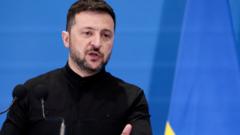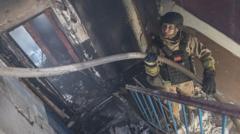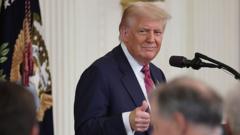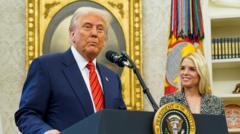As the conflict between Israel and Iran intensifies, with both sides exchanging heavy fire and significant casualties, the situation has prompted President Trump to return to Washington for urgent discussions.
**Escalating Conflict: Trump Returns to Washington Amid Heightened Violence Between Iran and Israel**

**Escalating Conflict: Trump Returns to Washington Amid Heightened Violence Between Iran and Israel**
President Trump cuts G7 summit trip short, indicating a shift in U.S. involvement as tensions escalate in the Middle East.
---
In a dramatic turn of events, President Trump exited the G7 summit in Alberta, Canada, early on June 17, returning to Washington as Israel and Iran engage in a fifth day of escalating conflict. While addressing reporters during the flight, Trump expressed his ambitions for a more definitive resolution than a mere ceasefire, asserting that he is looking for a "real end" to the hostilities. He called for Iran to capitulate and abandon its nuclear ambitions.
The military exchanges between Israel and Iran have been marked by a significant increase in hostilities. Israeli forces reported the assassination of another Iranian general, Maj. Gen. Ali Shadmani, just days into the conflict, and Iranian attacks have resulted in casualties in Israeli cities, including missile strikes reaching urban areas near Tel Aviv.
As civilian casualties mount—224 reported deaths in Iran alongside 24 in Israel—the pressure on the Trump administration is palpable. U.S. officials are being urged by Israel to join in the military efforts against Iran’s burgeoning nuclear capabilities, particularly targeting sites such as the heavily fortified Fordo facility. However, Trump has remained evasive regarding potential U.S. military involvement, emphasizing a preference for diplomatic channels.
At the same time, diplomacy may be in play. Iranian Foreign Minister Abbas Araghchi expressed openness to discussions about Iran's nuclear program, suggesting a series of high-level talks could reduce tensions. Meanwhile, amidst these discussions, the Group of 7 leaders issued a statement urging de-escalation, reflecting widespread concern about the continuing violence.
Notably, while the strikes continue, their impacts on civilians are weighing heavily on public sentiment in both Iran and Israel. Reports reflect mass evacuations in Tehran, highlighting fear among residents as they scramble for safety in anticipation of further escalated military action from Israel.
The conflict also evokes broader regional dynamics, particularly as Syria refrains from official comments. Analysts suggest that Syria's current governmental policy, coupled with historical ties with Iran, indicates a significant shift in regional alignments that could influence the ongoing war.
For now, Trump is confronted with a pivotal choice: whether to involve the U.S. militarily or work through diplomacy. His previous resistance to engaging in foreign conflicts adds an additional layer of complexity to an already volatile situation.
In a dramatic turn of events, President Trump exited the G7 summit in Alberta, Canada, early on June 17, returning to Washington as Israel and Iran engage in a fifth day of escalating conflict. While addressing reporters during the flight, Trump expressed his ambitions for a more definitive resolution than a mere ceasefire, asserting that he is looking for a "real end" to the hostilities. He called for Iran to capitulate and abandon its nuclear ambitions.
The military exchanges between Israel and Iran have been marked by a significant increase in hostilities. Israeli forces reported the assassination of another Iranian general, Maj. Gen. Ali Shadmani, just days into the conflict, and Iranian attacks have resulted in casualties in Israeli cities, including missile strikes reaching urban areas near Tel Aviv.
As civilian casualties mount—224 reported deaths in Iran alongside 24 in Israel—the pressure on the Trump administration is palpable. U.S. officials are being urged by Israel to join in the military efforts against Iran’s burgeoning nuclear capabilities, particularly targeting sites such as the heavily fortified Fordo facility. However, Trump has remained evasive regarding potential U.S. military involvement, emphasizing a preference for diplomatic channels.
At the same time, diplomacy may be in play. Iranian Foreign Minister Abbas Araghchi expressed openness to discussions about Iran's nuclear program, suggesting a series of high-level talks could reduce tensions. Meanwhile, amidst these discussions, the Group of 7 leaders issued a statement urging de-escalation, reflecting widespread concern about the continuing violence.
Notably, while the strikes continue, their impacts on civilians are weighing heavily on public sentiment in both Iran and Israel. Reports reflect mass evacuations in Tehran, highlighting fear among residents as they scramble for safety in anticipation of further escalated military action from Israel.
The conflict also evokes broader regional dynamics, particularly as Syria refrains from official comments. Analysts suggest that Syria's current governmental policy, coupled with historical ties with Iran, indicates a significant shift in regional alignments that could influence the ongoing war.
For now, Trump is confronted with a pivotal choice: whether to involve the U.S. militarily or work through diplomacy. His previous resistance to engaging in foreign conflicts adds an additional layer of complexity to an already volatile situation.






















